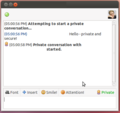 Next to the London tube, New York's underground transportation system is one of the few places I have noticed over the years that still lack wireless coverage on a broad scale. It looks like things are changing though as I was positively surprised to have coverage in one of New York's metro stations recently. Have a look at the picture on the left to see how the antennas look like. I had to smile a bit because the cables and antennas are significantly bigger than those in the Paris metro for example. Also one antenna in the Paris metro suffices for four networks while New York needs three. But then, everything seems to be a bit bigger in the US.
Next to the London tube, New York's underground transportation system is one of the few places I have noticed over the years that still lack wireless coverage on a broad scale. It looks like things are changing though as I was positively surprised to have coverage in one of New York's metro stations recently. Have a look at the picture on the left to see how the antennas look like. I had to smile a bit because the cables and antennas are significantly bigger than those in the Paris metro for example. Also one antenna in the Paris metro suffices for four networks while New York needs three. But then, everything seems to be a bit bigger in the US.
Anyway, I did a bit of background research to see how far the project has come so far. Looks like there are currently 36 stations covered but there is no talk of the tunnels in between the stations. For details see here. Better than nothing but that's lacking a bit of ambition. I am sure some will point to the fact that the New York metro is old and tunnels are narrow. That hasn't stopped in-tunnel coverage in Paris though where similar conditions can be found.
The article linked above has some interesting details concerning who pays for the deployment and how much it costs. It looks like a separate company called Transit Wireless was established to bundle all technical and financial matters:
Transit Wireless and the carriers are paying 100 percent of the cost of
the project, estimated at up to $200 million [MS: for around 280 stations], including the cost of NYC
Transit forces that provide flagging, protection and other support
services. The MTA and Transit Wireless evenly split the revenues from
occupancy fees paid by the wireless carriers and other sub-licensees of
the network. Transit Wireless is paying MTA a minimum annual
compensation that will grow to $3.3 million once the full build out of
the network is complete.
When dividing the $200 million by 280 base stations and potentially 4 network operators (leaving the Wi-Fi coverage that is also part of the project out of the equation for the moment) the cost of covering one station is about $180k per network operator. I can imagine that this is more than the costs of setting up a base station site above ground but it still seems to be a reasonable sum to me, especially when compared to the tens of thousands of people that pass through a station daily that generate traffic and revenue.
The post above then also describes some technical details of how coverage is distributed to the underground stations:
Wireless carriers […] co-locate their Base Stations with Transit Wireless’ Optical distribution equipment at a Transit Wireless Base Station Hotel, which is a resilient, fault-tolerant commercial facility with redundant air-conditioning and power.
[…] These Base Stations connect to Transit Wireless’ Radio Interface and Optical Distribution System in the Base Station Hotel. Radio signals are combined, converted to optical signals and distributed on Transit Wireless’ fiber optic cable through ducts under city streets to subway stations where the optical cables connect to multi-band Remote Fiber Nodes.
Remote Fiber Nodes are located on every platform, mezzanine and at various points within public access passageways. Coaxial cable is connected to each Remote Fiber Node and extends signals to strategically located antennas throughout each subway station. Utilizing this approach, low-level radio signals are evenly distributed providing seamless coverage from above ground to underground stations.
According to the article, the deployment includes free Wi-Fi as well which is good news for international travelers that are reluctant to use cellular data services due to high roaming charges.

